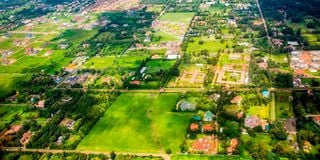Premium
Race for Karen, Muthaiga, Rosslyn homes hots up

An aerial of neighbourhoods in Nairobi.
What you need to know:
- Real estate agents say the elderly are looking for smaller and cozier homes with fewer rooms and lower maintenance.
- Those who are selling are moving to Maanzoni in Machakos, Champagne Ridge in Kajiado, and Tigoni in Kiambu.
More and more older, wealthier Kenyans are selling off their big homes in Nairobi’s Karen in search of quieter, smaller spaces as their children leave the nest and the upmarket estate becomes crowded.
Real estate agents say the elderly are looking for smaller and cozier homes with fewer rooms and lower maintenance.
“Most [of the sellers] are couples whose children have since grown and moved out to be on their own,” says Maggie Macharia of Pam Goldings, a real estate agent in Nairobi, who specialises in residential property sales in Karen.
“The sellers are mostly in their retirement age. Others are selling because Karen is progressively becoming more developed and popular hence they (sellers) feel they would be happy to explore life out of the city.”
Those who are selling are moving to “Maanzoni in Machakos, Champagne Ridge in Kajiado, and Tigoni in Kiambu.”
Tarquin Gross, the head of residential agency at Knight Frank, a real estate agent, says “some are looking to relocate towards Nanyuki, Naivasha or the North Coast in Kilifi, Watamu and Lamu.”
Where are most buyers coming from?
Ms Macharia says the majority of buyers vary from ultra-high-net-worth clients in the business, Kenyans living in the diaspora, and government officials.
“The buyers' ages vary, from ages 35 years to 80 years,” she says.
Mr Gross adds that many of the people buying homes in upmarket estates are those who have been tenants in the area and perhaps did not havethe means to buy but now have the capacity.
“A majority of transactions that we’ve seen over the last six months have either been in Karen, New Muthaiga, Gigiri area, old Muthaiga and Rosslyn. They [buyers] have worked and they are now looking to buy. There is also an expatriate community that might have moved to Kenya for an assignment or job posting but have decided to settle in Kenya,” he told Nation Lifestyle.

Head of residential Agency at Knight Frank, Tarquin Gross pictured during an interview with the Nation on September 7, 2023 in Karen.
“An acre of land in prime Karen now ranges between Sh60 million and Sh80 million. In Muthaiga, half an acre could cost anywhere between Sh150 million and Sh300 million. In New Muthaiga you’re looking to part with between Sh60 million to Sh100 million,” he says.
What is interesting, the real estate agents say, is the harsh economy that has slowed down the spending power of many Kenyans, has not affected the wealthy looking to buy and rent homes in the posh estates.
“When you talk of the luxury market, it is prime prices, and typically a prime buyer is not influenced by the economy. They have quite a lot of money,” Mr Gross says.
A majority of the buyers are looking for passive income, especially Kenyans living and working abroad.
“I would confidently say homes in Karen now have an occupancy rate of 90 percent on average. It is rare to find vacant homes in the very sought-after neighborhoods in Karen. This therefore makes it a very good investment zone for those seeking passive income,” Ms Macharia adds.
Sale and renting of prime properties may have slowed down during the pandemic but post-covid there has been a resurgence in prime purchases. Most of the purchases are second homes. The most expensive addresses in Nairobi’s Karen estate are now Miotoni Road and Windy Ridge.

An aerial of modern road network in Nairobi.
“We currently seem to have a market with an oversupply of buyers as opposed to stock/property availability thus pushing the prices up.
The prices have gone up in particularly high-end areas of Karen and not necessarily in the general Karen area, meaning the higher prices narrow down again to the very sought-after neighbourhoods.
“Currently, half an acre of land in Miotoni Road and Wind Ridge can easily go for between Sh35 million and Sh45 million whilst there are certain areas in Karen where the same size will go for Sh30 million. This is the same case for homes,” she says.
In Karen, most renters nowadays prefer Marula Lane, Bogani Road, Ndege Road and Hardy,” says Ms Macharia.
Mr Gross says that the majority of the renters in Muthaiga and Gigiri are expatriates because the United Nations offices and foreign embassies are located in that side of town.
“In Karen we have a few expatriates renting but we have a lot of Kenyan renters who like the scenery and like a bit more space. People like that in Karen, there is a little bit more greenery, more space and there are also good schools in Karen, good shopping centres.”
The rental prices are cheaper in Karen than in Muthaiga.
“Muthaiga has always been focused on the expat market whether it is for security reasons or amount of money put into the building. Muthaiga also has extremely beautiful properties that are well-built and bigger. On the other hand, for the longest time, Karen has been more suburban and slightly further a field where the UN securities and embassies would not let expats live. However, we are starting to see that change as more expats are willing to live in this side of town (Karen),” Mr Gross says.
What makes a home ranked as a prime?
Mr Gross says the location, size, quality, and available amenities are key determinants.
Prime residential areas are also sought after because of the functioning residential associations.
“The prime areas face very little disturbance; there are working residential associations that have a say in development plans. When you have a good residential association they protect that area and in prime areas like Karen, Muthaiga, the residential association can block that which is illegal,” he says.
Renting to the wealthy also comes with its advantages. Unlike in middle-income or low-income neighbourhoods where renters rent homes for short periods, a headache for landlords who have to look for new people every three months or so, those looking for homes in areas like Karen and Muthaiga rent long-term.
“Rental agreements can be for a minimum of one year to a maximum of three years but will also have break clauses. So we try to get into an agreement for one year then after the one year there is a break clause that will allow either party three months to end the agreement,” Mr Gross says.





